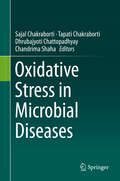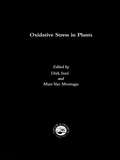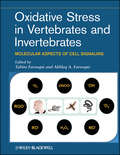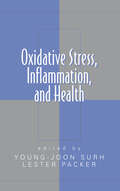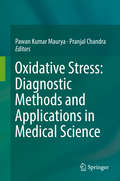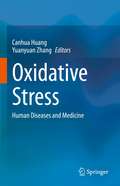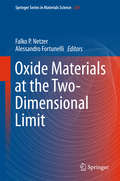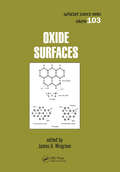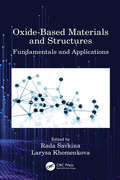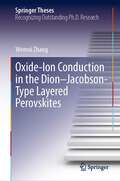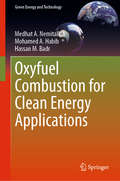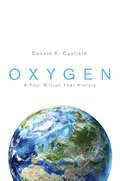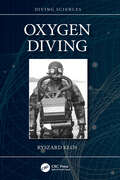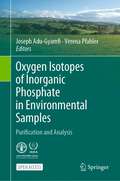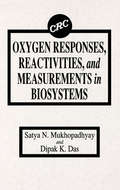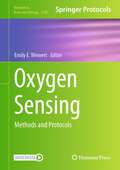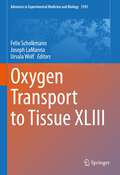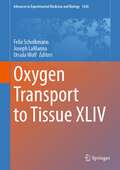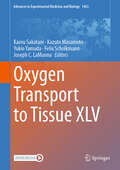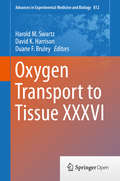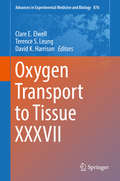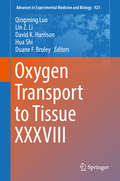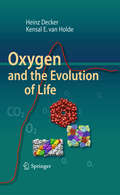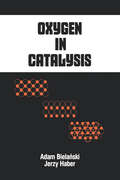- Table View
- List View
Oxidative Stress in Microbial Diseases
by Sajal Chakraborti Tapati Chakraborti Dhrubajyoti Chattopadhyay Chandrima ShahaThis book discusses recent advances in our understanding of the role of oxidants in microbial pathophysiology, providing valuable insights into the complex role of reactive oxygen species (ROS) in host-microbial interactions. The various chapters take readers through the function of ROS in infections ranging from viral to bacterial, and describe how microorganisms have developed complex strategies to not only avoid contact with phagocyte-derived oxidants, but also protect themselves from injury when oxidants are encountered. Featuring the latest research in the field of microbial diseases, this timely book is a ready reference for scientists looking to develop new anti-microbial drugs.
Oxidative Stress in Plants
by Dirk Inze Marc Van MontaguPlants depend on physiological mechanisms to combat adverse environmental conditions, such as pathogen attack, wounding, drought, cold, freezing, salt, UV, intense light, heavy metals and SO2. Many of these cause excess production of active oxygen species in plant cells. Plants have evolved complex defense systems against such oxidative stress. The
Oxidative Stress in Vertebrates and Invertebrates: Molecular Aspects of Cell Signaling
by Akhlaq A. Farooqui Tahira FarooquiThis volume presents a unique comparative treatment of the role oxidative stress plays in vertebrates and invertebrates in multiple organ systems with regards to cell death, development, aging, and human diseases, and anti-oxidant therapy. It offers comprehensive reviews of the current understanding of oxidative stress-mediated physiology and pathology as well as directions for future research. It also provides current information on the role of oxidative stress in neurodegenerative diseases, cardiovascular diseases, and various types of cancer mediated by oxidative stress.
Oxidative Stress, Inflammation, and Health (Oxidative Stress and Disease)
by Lester Packer Young-Joon SurhSpecifically focusing on the redox regulation of cell signaling responsible for oxidative stress and inflammatory tissue damage, this reference provides a comprehensive overview of cutting-edge research on the intracellular events mediating or preventing oxidative stress and pro-inflammatory processes induced by endogenous and xenobiotic factors-an
Oxidative Stress: Diagnostic Methods and Applications in Medical Science
by Pawan Kumar Maurya Pranjal ChandraThis book discusses the importance of oxidative stress, related biomarkers, and its diagnostic methods including bio-analytical and advanced detection systems. Oxidative stress is associated with diminished capacity of a biological system to overcome the overproduction of reactive oxygen species. Since oxidative stress has been suggested as a causative factor in many diseases, its prevention is vital, and there is an urgent need for oxidative stress monitoring using in vitro and in vivo models. Interdisciplinary approaches have lead to the development of various oxidative stress monitoring models for real-world clinical and biomedical applications. The development of such methods requires a broad understanding of biology, chemistry, molecular biology, immunology and microbiology. As such, the book is a valuable resource for students, researchers and clinicians interested in the fundamental as well as applied aspects of oxidative stress associated diseases.
Oxidative Stress: Human Diseases and Medicine
by Yuanyuan Zhang Canhua HuangThis book offers a systematic review of the cutting-edge knowledge in stress medicine. Cellular redox imbalance, resulting from overproduction of reactive oxide species (ROS), leads to oxidative stress and subsequent occurrence and development of many diseases, such as cancer, diabetes, pain, etc. In addition, ROS can induce post-translational modification of proteins and play roles through redox signaling pathways. In this book, the authors attempt to re-define the key concepts in oxidative stress, such as oxidative eustress and oxidative distress, revisit the pivotal signaling of oxidative stress in human diseases, and discuss the debate in current anti-oxidant strategies, such as natural products and drug repurposing. This book serves as a reference to graduate students and researchers in this growing field.
Oxide Materials at the Two-Dimensional Limit
by Falko P. Netzer Alessandro FortunelliThis book summarizes the current knowledge of two-dimensional oxide materials. The fundamental properties of 2-D oxide systems are explored in terms of atomic structure, electronic behavior and surface chemistry. The concept of polarity in determining the stability of 2-D oxide layers is examined, charge transfer effects in ultrathin oxide films are reviewed as well as the role of defects in 2-D oxide films. The novel structure concepts that apply in oxide systems of low dimensionality are addressed, and a chapter giving an overview of state-of-the-art theoretical methods for electronic structure determination of nanostructured oxides is included. Special emphasis is given to a balanced view from the experimental and the theoretical side. Two-dimensional materials, and 2-D oxides in particular, have outstanding behavior due to dimensionality and proximity effects. Several chapters treat prototypical model systems as illustrative examples to discuss the peculiar physical and chemical properties of 2-D oxide systems. The chapters are written by renowned experts in the field.
Oxide Semiconductors for Solar Energy Conversion: Titanium Dioxide (Green Chemistry and Chemical Engineering)
by Janusz NowotnyOxide semiconductors, including titanium dioxide (TiO2), are increasingly being considered as replacements for silicon in the development of the next generation of solar cells. Oxide Semiconductors for Solar Energy Conversion: Titanium Dioxide presents the basic properties of binary metal oxide semiconductors and the performance-related properties
Oxide Surfaces (Surfactant Science)
by James A. WingraveA detailed treatment of information relating to fluid-oxide interfaces. It outlines methods for quantifying adsorption and desorption of polymeric and non-polymeric solutes at the gas- and solution-oxide interfaces. It also analyzes novel properties of oxide membranes and the synthesis and dissolution of oxide solids.
Oxide-Based Materials and Structures: Fundamentals and Applications
by Rada SavkinaOxide-based materials and structures are becoming increasingly important in a wide range of practical fields including microelectronics, photonics, spintronics, power harvesting, and energy storage in addition to having environmental applications. This book provides readers with a review of the latest research and an overview of cutting-edge patents received in the field. It covers a wide range of materials, techniques, and approaches that will be of interest to both established and early-career scientists in nanoscience and nanotechnology, surface and material science, and bioscience and bioengineering in addition to graduate students in these areas. Features: Contains the latest research and developments in this exciting and emerging field Explores both the fundamentals and applications of the research Covers a wide range of materials, techniques, and approaches
Oxide-Ion Conduction in the Dion–Jacobson-Type Layered Perovskites (Springer Theses)
by Wenrui ZhangThis book reports a study of a class of Dion–Jacobson-type layered perovskite oxides in which high oxide-ion conductivities in phases were discovered for the first time in the world. The oxide-ion conductors are important in various energy conversion devices and environmental protection applications such as solid-oxide fuel cells, oxygen gas sensors, oxygen separation membranes, and oxygen-based catalysts. The discoveries are based on a new screening method, called the bond valence method, combined with an original design concept. The present finding of high oxide-ion conductivity reported in the thesis suggested the potential of Dion–Jacobson phases as a platform to identify superior oxide-ion conductors.To understand what causes such high oxide-ion conductivities in these layered perovskite oxides, the author analyzed their crystal structures at high temperature and described the relationship between oxide-ion conductivities and their crystal structures. A deep understanding of the mechanisms of oxide-ion diffusivity at an atomic level in the Dion–Jacobson phases is clarified.The discovery of these materials, the new screening method, and the original design concept make possible the realization of many environment-friendly technologies. The findings in this thesis facilitate the possibilities for many novel applications that will help lead to a sustainable future.
Oxyfuel Combustion for Clean Energy Applications (Green Energy and Technology)
by Hassan M. Badr Medhat A. Nemitallah Mohamed A. HabibThis book aims to be the reference book in the area of oxyfuel combustion, covering the fundamentals, design considerations and current challenges in the field. Its first part provides an overview of the greenhouse gas emission problem and the current carbon capture and sequestration technologies. The second part introduces oxy-fuel combustion technologies with emphasis on system efficiency, combustion and emission characteristics, applications and related challenges. The third part focuses on the recent developments in ion transport membranes and their performance in both oxygen separation units and oxygen transport reactors (OTRs). The fourth part presents novel approaches for clean combustion in gas turbines and boilers. Computational modelling and optimization of combustion in gas turbine combustors and boiler furnaces are presented in the fifth part with some numerical results and detailed analyses.
Oxygen
by Donald E. CanfieldThe air we breathe is twenty-one percent oxygen, an amount higher than on any other known world. While we may take our air for granted, Earth was not always an oxygenated planet. How did it become this way? Oxygen is the most current account of the history of atmospheric oxygen on Earth. Donald Canfield--one of the world's leading authorities on geochemistry, earth history, and the early oceans--covers this vast history, emphasizing its relationship to the evolution of life and the evolving chemistry of the Earth. With an accessible and colorful first-person narrative, he draws from a variety of fields, including geology, paleontology, geochemistry, biochemistry, animal physiology, and microbiology, to explain why our oxygenated Earth became the ideal place for life. Describing which processes, both biological and geological, act to control oxygen levels in the atmosphere, Canfield traces the records of oxygen concentrations through time. Readers learn about the great oxidation event, the tipping point 2.3 billion years ago when the oxygen content of the Earth increased dramatically, and Canfield examines how oxygenation created a favorable environment for the evolution of large animals. He guides readers through the various lines of scientific evidence, considers some of the wrong turns and dead ends along the way, and highlights the scientists and researchers who have made key discoveries in the field. Showing how Earth's atmosphere developed over time, Oxygen takes readers on a remarkable journey through the history of the oxygenation of our planet.
Oxygen Diving (Diving Sciences)
by Ryszard KlosThe book provides a derivation of the models used for calculating the risk and hazard of central oxygen toxicity pertaining to diving-based studies consistent with the research conducted earlier by the Royal Navy and the US Navy. This book forms the basis for extending the possibility of undertaking nitrox dives in combination with oxygen dives, thus significantly increasing tactical capabilities of conducting diving special operations. Features: provides derivation of the models used for calculating the risk and hazard of central oxygen toxicity improves oxygen diving procedures described in the US Navy Diving Manual includes procedures applicable to undertaking nitrox dives in combination with oxygen dives pitches the material at highest technology readiness levels, i.e. 9 TRL aims to increase tactical capabilities of conducting diving special operations This book is aimed at researchers, professionals and graduate students in life support system design, diving submarine safety, ventilation, health, sanitary engineering, mining engineering and working environment in chambers or closed compartments.
Oxygen Isotopes of Inorganic Phosphate in Environmental Samples: Purification and Analysis
by Joseph Adu-Gyamfi Verena PfahlerThis open access book distinguished itself from other publications by offering step-by-step instructions on how to extract, purify, provide modifications, and major issues to be encountered during the process. For the δ18OP method to progress, further fundamental research as well as field and laboratory studies need to be conducted for a better understanding of P cycling in the environment. Chapter 1 outlines the background and examples of δ18Op studies in sediments, soils, fresh water, mineral fertilizers, and plants. Chapters 2 and 3 examine the stepwise extraction and purification protocols including reagents, equipment and consumables and preparations for analyses. Chapter 4 examines some of the challenges and modifications during the purification process. Chapter 5 discusses planning and designing of a study using δ18Op, external quality assurance with an example of an inter-laboratory study. Chapter 6 outlines the conclusions, future trends, and opportunities, the scaling out of the method from laboratory to field studies. It is expected that the δ18OP would be extensively applied in research geared to understand phosphorus dynamics in different agro-environments.
Oxygen Responses, Reactivities, and Measurements in Biosystems
by S. N. Mukhopadhyay Dipak K. DasOxygen Responses, Reactivities, and Measurements in Biosystems meets the pressing needs of the twentieth-century biotechnological and bioengineering sciences in covering oxic reactions and oxygen transport phenomena in a single book. This book is intended for teaching senior or graduate level courses and as a self-study text for practicing biochemical and chemical engineers, biotechnologists, applied and industrial microbiologists, cell biologists, scientists involved in oxygen-free radical research, and others in related fields. The text includes thought-provoking numerical problems and short questions, conventional biochemical engineering approaches and related concepts with mathematical formulations and analysis, concepts of cell biology, basic microbiology and applied biochemistry in oxy radical research, practical approaches for the development of laboratory experiments and industrial design, and an introduction of oxygen-free radical chemistry to biotechnology and bioengineering.
Oxygen Sensing: Methods and Protocols (Methods in Molecular Biology #2648)
by Emily E. WeinertThis volume provides researchers with protocols that help them investigate known or putative O2 sensing proteins and pathways. The chapters in this book discuss techniques ranging from anaerobic redox midpoint measurement to approaches to control expression of globin genes, which provide detailed methods for researchers interested in expanding their knowledge of O2 sensing systems. Written in the highly successful Methods in Molecular Biology series format, chapters include introductions to their respective topics, lists of the necessary materials and reagents, step-by-step, readily reproducible laboratory protocols, and tips on troubleshooting and avoiding known pitfalls.Authoritative and comprehensive, Oxygen Sensing: Methods and Protocols is a valuable resource to a wide audience, ranging from microbiologists and cell biologists, to protein biochemists.
Oxygen Transport to Tissue XLIII (Advances in Experimental Medicine and Biology #1395)
by Ursula Wolf Felix Scholkmann Joseph LaMannaThis book contains most of the scientific contributions during the 48th annual conference of the International Society on Oxygen Transport to Tissue (ISOTT), which was held electronically in July 2021. It includes multidisciplinary contributions from scientists (physicists, biologists and chemists), engineers, clinicians and mathematicians and covers covers all aspects of oxygen transport from air to the cells, organs and organisms; instrumentation and methods to sense oxygen and clinical evidence.
Oxygen Transport to Tissue XLIV (Advances in Experimental Medicine and Biology #1438)
by Ursula Wolf Felix Scholkmann Joseph LaMannaThis book presents cutting-edge papers and perspectives on the transport of oxygen to tissues by scientists in a multitude of disciplines such as biochemistry, engineering, mathematics, medicine, physics, physiology, veterinary and complementary medicine. The book is composed of the following 6 parts: Brain Oxygenation and Function, Tumor Oxygenation and Metabolism, Muscle Oxygenation and Sports Medicine, Cell Metabolism and Tissue Oxygenation, Methodology of O2 Measurements, and Special Topics. The articles in this book have been presented at the 49th annual meeting of the International Society on Oxygen Transport to Tissue (ISOTT 2022). Academics, clinical and industry researchers, engineers, as well as graduate students who are interested in oxygen transport to tissue will find this book a great reference and a useful learning resource.
Oxygen Transport to Tissue XLV (Advances in Experimental Medicine and Biology #1463)
by Joseph C. LaManna Felix Scholkmann Kaoru Sakatani Kazuto Masamoto Yukio YamadaThis book presents cutting-edge papers and perspectives on the transport of oxygen to tissues by scientists in a multitude of disciplines such as biochemistry, engineering, mathematics, medicine, physics, physiology, veterinary and complementary medicine. The book is composed of the following 7 parts: 50th Anniversary, Brain, Clinical applications, Methods and techniques, Tumor Oxygenation, Tissue oxygenation and Muscle. The articles in this book have been presented at the 50th annual meeting of the International Society on Oxygen Transport to Tissue (ISOTT 2023). Academics, clinical and industry researchers, engineers, as well as graduate students who are interested in oxygen transport to tissue will find this book a great reference and a useful learning resource.
Oxygen Transport to Tissue XXXVI
by Duane F. Bruley David K. Harrison Harold M. SwartzThis book contains the refereed contributions from the 41st annual meeting of ISOTT. The annual meetings of ISOTT bring together scientists from various fields (medicine, physiology, mathematics, biology, chemistry, physics, engineering, etc. ) in a unique international forum. Traditionally, ISOTT conferences are a place, where an atmosphere of interaction is created, where many questions are asked after each presentation and lively discussions occur at a high scientific level. This vivid interaction is the main motivation for members to participate and gain new ideas and knowledge in the broad field of oxygen transport to tissue. The papers in this volume summarize some of the outstanding contributions from the 41st annual meeting. Special features in this volume include invited presentations from senior members of ISOTT for the theme "the wisdom of ISOTT" in which founders, past presidents and prize winners from previous meetings provided both cutting edge new knowledge and integrated overviews of critical aspects of the field. The presentations and manuscripts also include those provided by the special opportunity provided by having part of the ISOTT meeting overlap with the EPR-2013 meeting where both focused on preclinical and clinical measurements of oxygen, with a particular emphasis on cancer.
Oxygen Transport to Tissue XXXVII
by David K. Harrison Clare E. Elwell Terence S. LeungThis book contains the refereed contributions from the 42nd annual meeting of ISOTT. The annual meetings of ISOTT bring together scientists from various fields (medicine, physiology, mathematics, biology, chemistry, physics, engineering, etc. ) in a unique international forum. ISOTT conferences are a place where an atmosphere of interaction is created, where many questions are asked after each presentation and lively discussions occur at a high scientific level. This vivid interaction is the main motivation for members to participate and gain new ideas and knowledge in the broad field of oxygen transport to tissue. The papers in this volume summarize some of the outstanding contributions from the 42nd annual meeting, which included sessions on: cellular hypoxia and mitochondria; blood substitutes and oxygen therapeutics; oxygen transport in critical care medicine and disease; muscle oxygenation; multi modal imaging techniques; brain oxygenation and imaging; optical techniques for oxygen measurement; microcirculation; mathematical modelling of oxygen transport; and cancer metabolism.
Oxygen Transport to Tissue XXXVIII
by Duane F. Bruley David K. Harrison Qingming Luo Lin Z. Li Hua ShiThis book contains the refereed contributions from the 43rd annual meeting of ISOTT. The annual meetings of ISOTT bring together scientists from various fields (medicine, physiology, mathematics, biology, chemistry, physics, engineering, etc. ) in a unique international forum. ISOTT conferences are a place where an atmosphere of interaction is created, where many questions are asked after each presentation and lively discussions occur at a high scientific level. This vivid interaction is the main motivation for members to participate and gain new ideas and knowledge in the broad field of oxygen transport to tissue. The proceedings include sessions covered various research topics including Multi-Modal Imaging/Spectroscopy & Instrumentation; Cancer Metabolism; Cellular Hypoxia and Mitochondrial Function; Brain Oxygenation and Function; Other Organ Function and Metabolism; Oxygen Transport in Sports, Diseases and Clinical Care; Acupuncture, Meridians, and Primo Vascular System; EPR, MRS and MRI.
Oxygen and the Evolution of Life
by Heinz Decker Kensal E HoldeThis book describes the interlaced histories of life and oxygen. It opens with the generation of oxygen in ancient stars and its distribution to newly formed planets like the Earth. Free O2 was not available on the early Earth, so the first life forms had to be anaerobic. Life introduced free O2 into the environment through the evolution of photosynthesis, which must have been a disaster for many anaerobes. Others found ways to deal with the toxic reactive oxygen species and even developed a much more efficient oxygen-based metabolism. The authors vividly describe how the introduction of O2 allowed the burst of evolution that created today's biota. They also discuss the interplay of O2 and CO2, with consequences such as worldwide glaciations and global warming. On the physiological level, they present an overview of oxidative metabolism and O2 transport, and the importance of O2 in human life and medicine, emphasizing that while oxygen is essential, it is also related to aging and many disease states.
Oxygen in Catalysis (Chemical Industries)
by Adam Bielanski Jerzy HaberA description of catalytic systems commonly used as model systems in the laboratory and as industrial catalysts in large-scale operations, and a discussion of the mechanisms operating in these reactions. Attempts to describe the elementary steps by quantum chemical methods are also shown, as are rec
